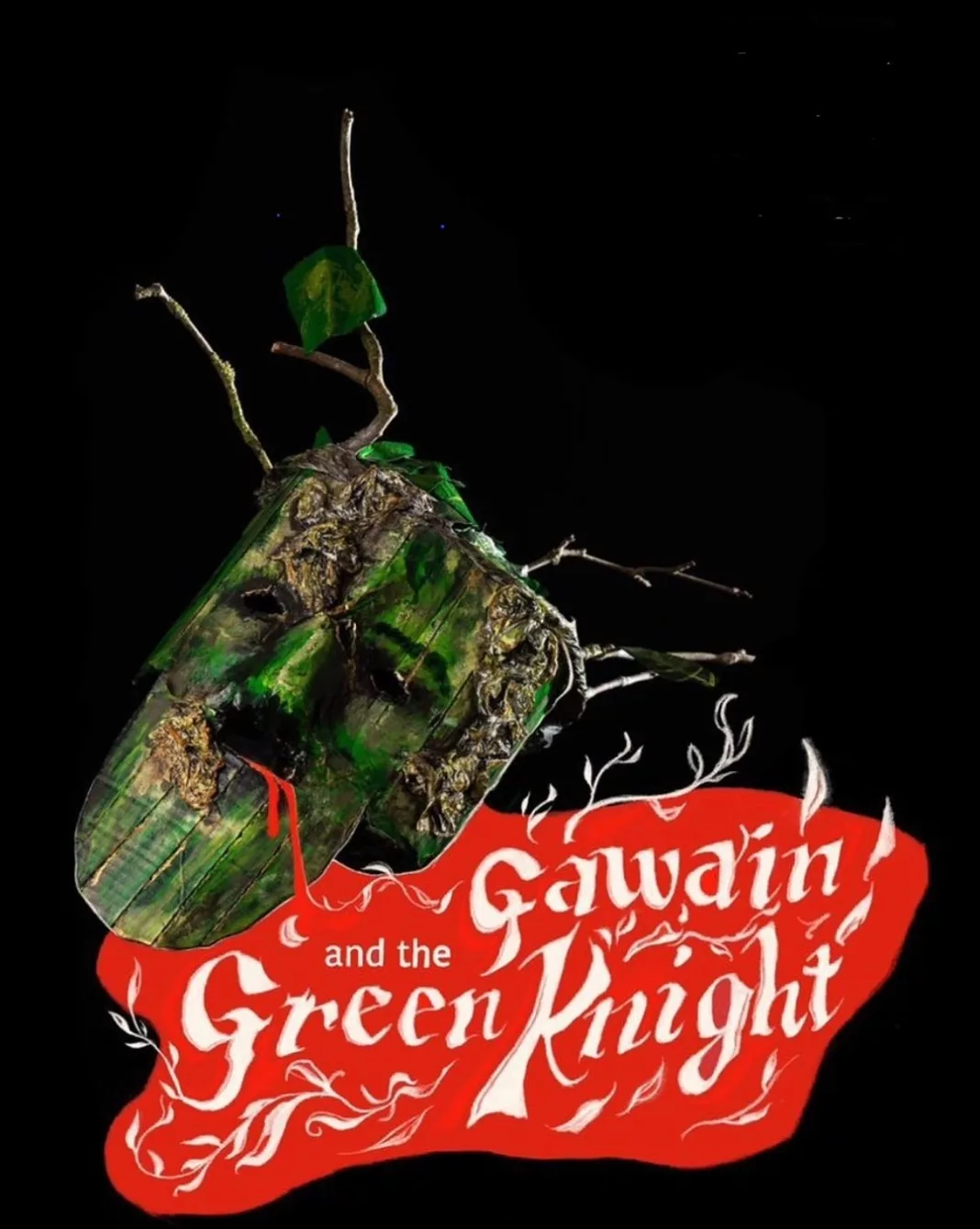Gawain and the Green Knight was a play I was eager to see. The title promises strange and exciting adventurers from Arthurian myth; the promotion posters gave us an eclectic mix of mysterious objects including the all-important Green Knight mask (a very well made prop) with its hollow eyes and crown of leaves. Performed in the BT studio, the playgoer has to dip down a side street behind the Oxford Playhouse and ascend a tight staircase to the very attic itself. It was all very mystical. Going into the small theatre, however, I hit a stumbling block at the sight of the set, which seemed to be decorated solely with mudstained sheets with sections of runes scrawled on them. It wasn’t exactly Camelot, or the woods of Arthurian myth. The play hit another wrongfooting before it had even begun, with the jarring sight of the Green Knight himself crouched diminutively in an alcove behind the curtains, probably hoping not to be seen. As we waited for the rest of the cast to arrive, I puzzled over how the play would turn out. Were these little oversights simply anomalies, or were they a taste of things to come?
The first thing I noticed was the costumes. In the first scene, these were very fun, and the Green Knight was decidedly impressive. Arthur’s Court wore black tie, but augmented with fur capes, jewels, horns and silver makeup. It was a fashionable and modern take, and we were back into that realm of the mystical and supernatural that all the advertising had tried to put forward. The Green Knight wore a makeshift ensemble of cardboard, plastic plants, green paint and a wetsuit, but thankfully it didn’t look like it – in the dim lighting he made a fantastical figure, particularly with the black-eyed, staring mask. But as the play went on, costume quality began to deteriorate. Once Gawain reached the castle, he was greeted by a cast of servants whose modern uniforms were plain and unoriginal. Worse was the Lady herself, whose uninspiring green dress may have been salvageable had it not been for the glittery green shoes she was wearing them with. They were unpleasant to look at and made it constantly hard to take her seriously.
Costume is not everything, and doesn’t doom a play by any means. A good set would have gone some way to offset it, but this was sadly something else the production was lacking. Set design was reduced to the ugly aforementioned sheets and occasional use of a carpet or a box. Without the sheets it could have aimed for minimalism, with them it became confusing. The set was at its weakest in the scenes where characters went behind the sheets to have conversations. They were semi-transparent, but not enough: I found myself sometimes straining to see what was going on. Lighting went some way to saving the situation, however, particularly in the Green Chapel scene where green lights and a forest soundscape did their best to offset the lacklustre set.
Again, none of this is fatal. The best actors can save any production. Gawain and the Green Knight sadly did not have them. You would think, from the title of Gawain and the Green Knight, that such a play would be a somewhat two man show, and it would have been better had this been the case, because, whilst neither Gawain nor the Green Knight were astounding actors, both showed an impressive degree of skill and were highly enjoyable to watch. The supporting cast, however, failed to blow me away. Performance was often lacklustre, or otherwise felt forced and artificial. Jokes frequently fell flat and an emotional connection was hard to make. Gawain and the Green Knight went some way to offset this, but they could only do so much. It was a somewhat disappointing spectacle.
To be fair to the cast, they were let down some of the way by an equally disappointing script. It is hard to be funny when the jokes aren’t, and hard to be convincing when the dialogue isn’t. Grappling with a traditional medieval story, the writer seemed unsure as to what period their language was coming from, and it floated uncomfortably between archaic terms and modern ones. The story was changed very little from its inspiration, but notable was the conclusion, where Gawain’s harrowing experiences and the apathy of Arthur’s court provoke in him a grim epiphany, whereon the lights fade to black. This silly detail felt like a botched war flashback and created an abrupt and uncomfortable cliffhanger.
Gawain and the Green Knight is a challenging piece of source material to compose a play from. The titular characters tried their best, but sadly, it was not enough. Initially at least aesthetically pleasing, this play stumbled from one poor decision to the next. It would be unfair to say that Gawain and the Green Knight was all bad, but the ultimate effect was one of disappointment.


